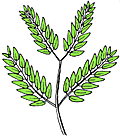ʻAmaʻu
Sadleria cyatheoides
Chainferns family (Blechnaceae)
Native species ()
This common trunked fern growing on open lava flows and in wet forests at middle altitudes through the Hawaiian Islands resembles a small treefern and becomes treelike. This species will serve as an example for its of five or six species.

©2015 Forest And Kim Starr
Leaves, several, large, feathery, spreading from top of trunk, developing from a large coil with long golden brown narrow flattened 3–5 ft (0.9–1.5 ) long. Leafstalk or axis () 1–2 ft (0.3–0.6 ) long, light green, flattened above, densely covered at base with long golden brown narrow flattened hairlike to 2 inches (5 ) long, hairless above. () 2–3 ft (0.6–0.9 ) long, oblong, nearly hairless, twice divided (). Branches () 30–40 on a side, 6–10 inches (15–20 ) long and 1⁄2–1 inch (1.3–2.5 ) wide, divided almost to base into many narrow oblong curved segments, blunt at and turned down on edges, hairless, slightly thickened, upper surface slightly shiny green with fine sunken and inconspicuous side veins, lower surface dull whitish green.
Older leaves bear, on lower leaf surfaces along two long black folds or lines (indusia) and between them a mass (sorus) of numerous dark brown cases () that shed powdery masses of microscopic abundantly. Under favorable conditions like seeds, develop into new plants.
Common and widespread in wet forests and open areas to 5500 ft (1676 ) altitude through the Hawaiian Islands.
Special areas
Haleakala, Volcanoes
Other common names
‘ama‘uma‘u, ma‘uma‘u, ma‘u
The trunked ferns of Sadleria are widespread within Hawaii. They grow under extreme conditions, from near the sea to mountain peaks, from rain forests to barren new lava flows, where they are among the pioneers or first plants to become established.
These ferns serve as nurse plants and soil for ‘ōhi‘a lehua, Metrosideros polymorpha. The tiny windborne tree seeds lodge in the scaly and leafy fern stems and germinate there. Then the young trees, deriving moisture and nutrients from the fern leaves, crowd and replace the ferns. A weevil that bores into the stems and damages the leaves has become a pest locally in recent years.
Various uses by the Hawaiians have been summarized by Degener (1930). Formerly, the soft hairlike of the young leaves were gathered commercially with those of the larger treeferns for stuffing mattresses and pillows. leaf-stalks of this fern were beaten and used as sizing with bark in making tapa, or bark cloth. The large leaves served as thatch for the houses, especially at corners and ridges. For dry-land vegetable crops the served as ground cover or mulch. The starchy, almost tasteless inner part of the trunks was cooked in the ground and eaten, mainly in times of famine. The young leaves, which taste like asparagus, were cooked also. A red dye for bark cloth was extracted from the outer pan of the trunk by mashing the fibers and then squeezing the sap into a vessel. This liquid was then boiled with hot stones added to protect the container.
Halemaumau, the fire pit within Kilauea Crater, means “the house of ‘ama‘uma‘u fern.”
This species is the type of the Sadleria. The name commemorates Joseph Sadler (1791–1849), Hungarian botanist and physician.


